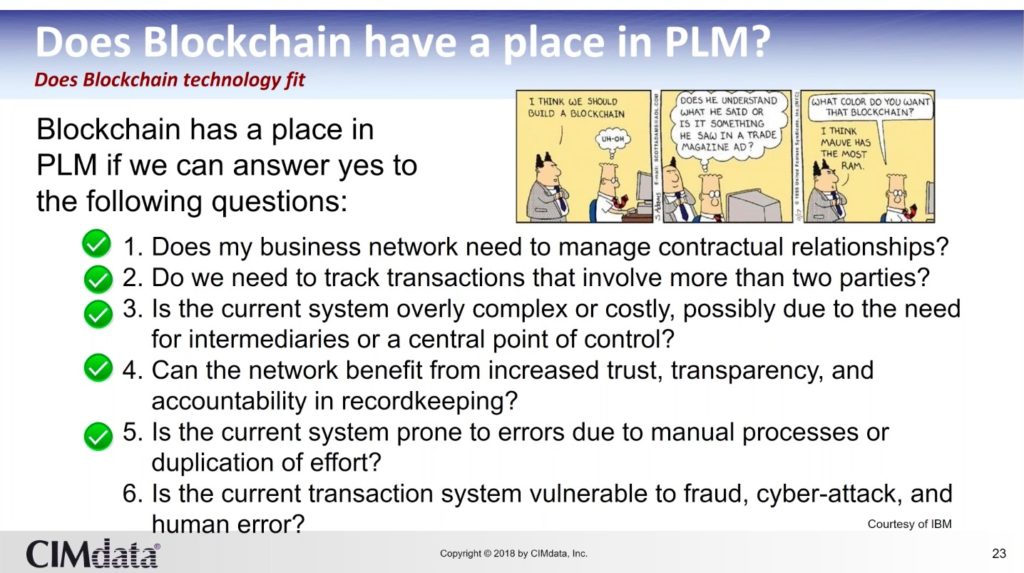
One of the trending technologies these days is blockchain. Unless you live under the rock for the last few years, you probably heard about it. Blockchain is designed to be resistant to modification of data and therefore there is a growing interest to use blockchain to implement variety of applications demanding persistent storage of data with guarantee of immutability.
The interest in blockchain technologies is growing and, therefore you can ask a question about possible use of blockchain in PLM products and technologies. It is worth to check CIMdata webinar – Blockchain Technology and PLM Usage. You can get access in exchange of registration. I captured the following slide to share:

You can also check some of my earlier blogs – Blockchain Technologies and Distributed Manufacturing Ledger and Which PLM will climb First to Discover Blockchain Opportunity? CAD and PLM vendors are paying attention to blockchain as well Here are few links –The Future of Supply Chain Transparency: PLM meets the IoT and Blockchain by WhichPLM and Blockchain Technology and PLM by Autodesk. As you can see from the articles, there is no much consensus about how PLM can discover the value of blockchain.
Outside of PLM space, you can hear different voices about blockchain. While nobody is questioning core concepts and ideas, the most interesting thing is timing. As you know, for new technologies, the timing is everything. You start too early and cash is burned for market discovery to be used by your followers. And if you start too late, you lose market to somebody who did it before. My favorite statement about timing belongs to Peter Thiel:
You’ve probably heard about “first mover advantage”: if you’re the first entrant into a market, you can capture significant market share while competitors scramble to get started. That can work, but moving first is a tactic, not a goal. What really matters is generating cash flows in the future, so being the first mover doesn’t do you any good if someone else comes along and unseats you. It’s much better to be the last mover — that is, to make the last great development in a specific market and enjoy years or even decades of monopoly profits.
My attention was caught by ZDNet article – What is the future of blockchain? The article speaks about 2018 Future of Blockchain survey from venture capital firm UnderscoreVC highlights blockchain insights by identifying new opportunities, disarming any threats or challenges, and advances the discussion on the future of blockchain.
Here are 2 important data points I captured from the survey: 1/ Only 1% of CIOs indicated some kind of blockchain adoption; 2/ Gartner doesn’t expect big returns from blockchain until 2025.
Most current uses of blockchain are not disruptive, because, according to Gartner, “the majority of organizations that undertake blockchain projects find it hard to conceive of systems that are outside of their legacy, centralized models (both business models and technology platforms).” Yet a Gartner survey shows that 66 percent of business leaders believe blockchain is a business disruption and have set budgets accordingly; and 5 percent of those surveyed said they will spend over $10 million on blockchain. But a 2018 Gartner CIO survey of 3,000 CIOs from 98 countries found that “only 1 percent of CIOs indicated any kind of blockchain adoption within their organizations.”
According to Gartner, the business value-add of blockchain will grow to slightly more than $176 billion by 2025, and then it will exceed $3.1 trillion by 2030. Gartner does not expect large returns on blockchain until 2025.
However, the most interesting one is related to blockchain and enterprise. While I continuously heard about enterprise blockchain opportunity, survey is actually disagreed about it.
Enterprise blockchain adoption: Enterprises are excited about the promise of blockchain, and many like IBM are actively taking leadership in the space. 1/ 69 percent of respondents believe that the enterprise has very low ability to implement blockchain technology in their organization. 2/ 75 percent of people believe that private blockchains will accelerate adoption.
“One of the most surprising results was that 78 percent of people believe that enterprise adoption was going to help accelerate overall blockchain adoption. It’s actually a finding in the survey that we disagree with. And in at least one sign of why — 69 percent believe the enterprise has very low ability to implement Blockchain.
Building on our 16 years of investing experience, surveys, and understanding the way Open Source and Cloud Computing have been adopted, the enterprise has generally been a laggard. We expect the same will be true of blockchain. We believe that the public blockchain will be the area of innovation, and the way that will come about is with startups.” — Michael Skok.
The last comment is resonating with some of my experience. I started to write about PLM and cloud in 2008. It has been 10 years since then and I can see real adoption of cloud by enterprise IT in 2018. Blockchain in 2018 is reminding me cloud PLM in 2008-2010.
What is my conclusion? We’re at the very early beginning of blockchain in enterprise and manufacturing. There are lot of ideas, discussions, technological and product attempts and speculations. However, I don’t see an agreement about use cases and potential ROI from manufacturing companies. So, note to all blockchain enthusiasts – keep looking and the dream will come true. Just my thoughts…
Best, Oleg
Want to learn more about PLM? Check out my new PLM Book website.
Disclaimer: I’m co-founder and CEO of OpenBOM developing cloud based bill of materials and inventory management tool for manufacturing companies, hardware startups and supply chain. My opinion can be unintentionally biased.
The post PLM blockchain dreams appeared first on Beyond PLM (Product Lifecycle Management) Blog.



Be the first to post a comment.